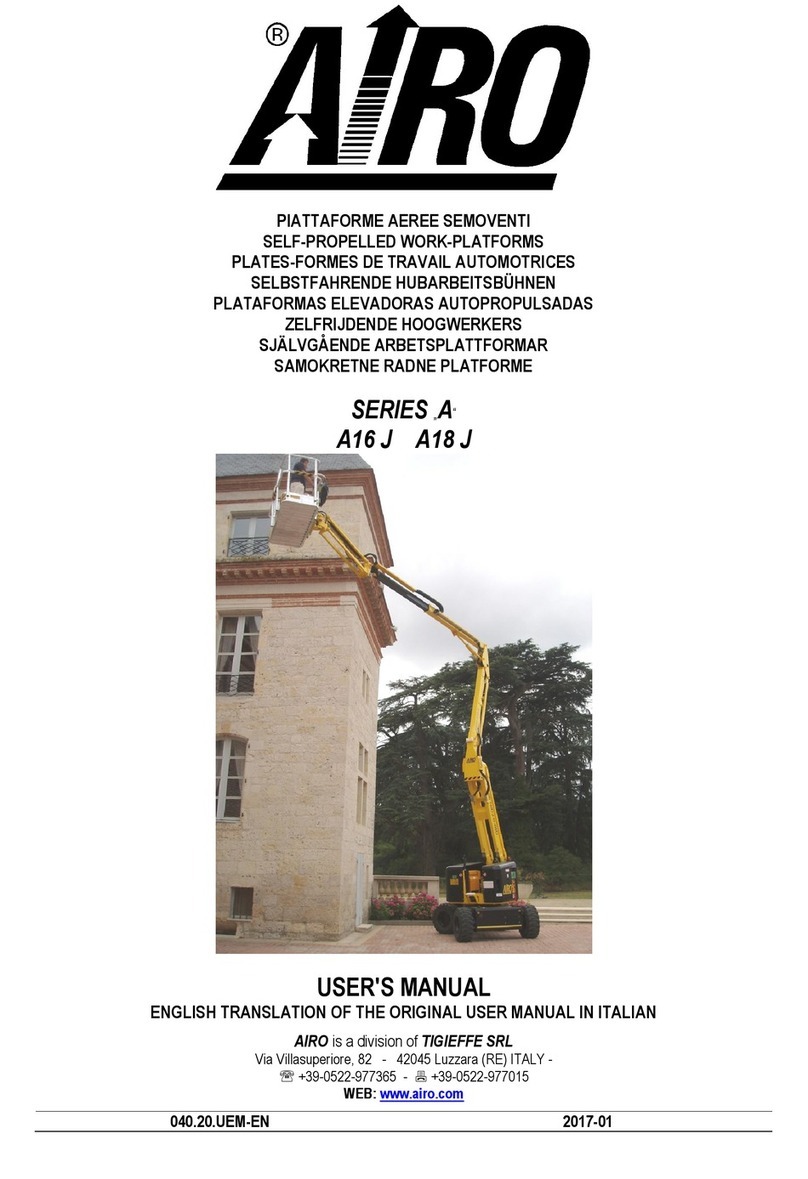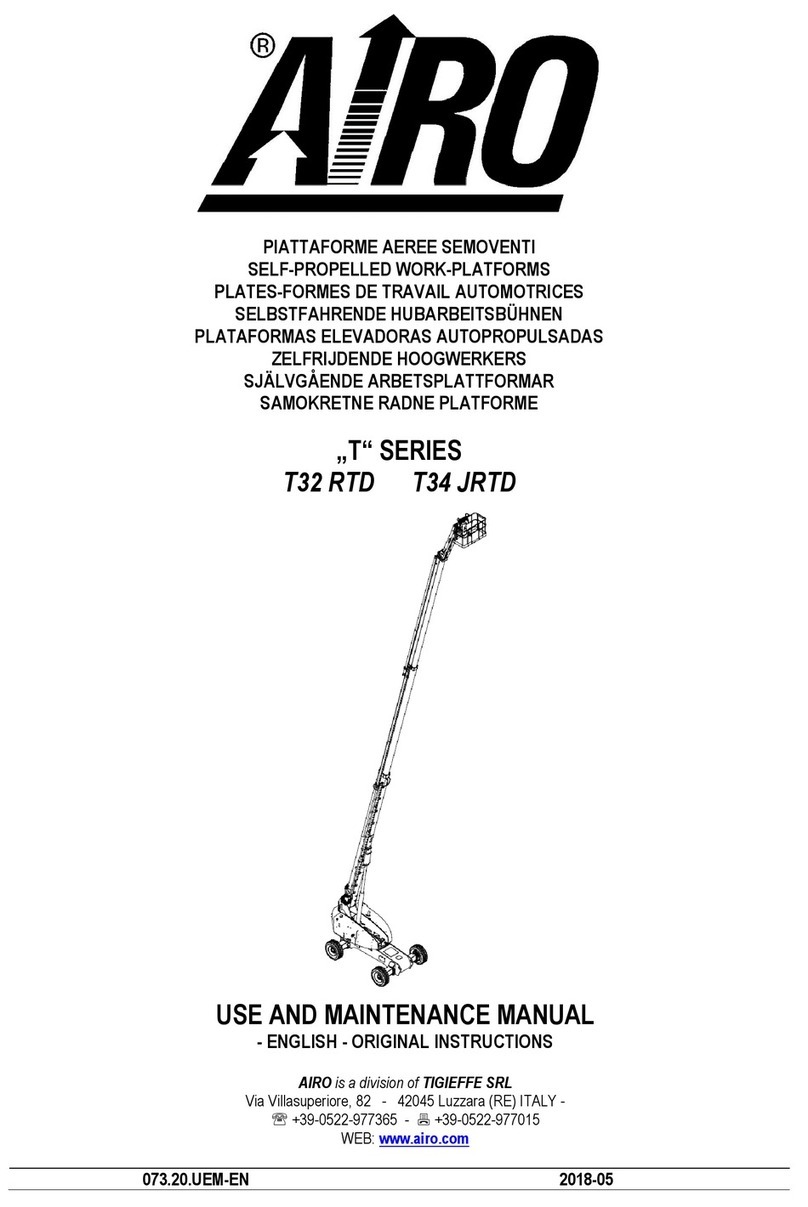
Tigieffe thanks you for purchasing a product of its range and reminds you to read this manual and familiarize with its contents
before using the machine. The information in this manual is crucial for the correct use of your aerial work platform and you should
be familiar and comply with these instructions for your own safety. Please don't throw this manual, take some time to read it
through. It's for your own sake and for a better use of your new asset. Please store this manual in a safe place, but at quick-reach
in case of need. The contents of this manual may be modified as a result of any change or improvement done by the manufacturer.
This will involve no prior notice and no other obligations of the manufacturer to make any upgrade, change, or improvement of the
units already in the market. The reproduction or translation of the whole manual or parts thereof is strictly forbidden without prior
written approval of the owner.
CONTENTS
1. INTRODUCTION ......................................................................................................................................................................... 5
1.1. Legal mentions .................................................................................................................................................................... 5
1.1.1. Delivery of the machine ............................................................................................................................................... 5
1.1.2. Statements of successful commissioning, first installation test, periodical functional tests and property transfers..... 5
1.1.2.1. Statements of successful commissioning carried out by the first owner. ................................................................. 5
1.1.2.2. Additional Periodical Tests....................................................................................................................................... 6
1.1.2.3. Transfers of ownership ............................................................................................................................................ 6
1.1.3. Operators training and information .............................................................................................................................. 6
1.2. Tests performed before delivery .......................................................................................................................................... 6
1.3. Application field.................................................................................................................................................................... 6
1.3.1. Deboarding Off-ground. ............................................................................................................................................... 7
1.4. Description of the machine .................................................................................................................................................. 7
1.5. Operator's control stations ................................................................................................................................................... 8
1.6. Power supply ....................................................................................................................................................................... 8
1.7. Machine life, demolition and decommissioning................................................................................................................... 8
1.8. Identification......................................................................................................................................................................... 9
1.9. Location of the main components...................................................................................................................................... 10
2. TECHNICAL FEATURES OF STANDARD MACHINES (DIMENSIONS AND PERFORMANCE)........................................... 11
2.1. Vibrations and noise. ......................................................................................................................................................... 13
3. SAFETY SIGNS ........................................................................................................................................................................ 14
3.1. Personal protection devices (PPE). ................................................................................................................................... 14
3.2. General Safety Rules......................................................................................................................................................... 14
3.3. General.............................................................................................................................................................................. 15
3.3.1. Operating Tips and Instructions................................................................................................................................. 15
3.3.2. Handling..................................................................................................................................................................... 15
3.3.3. Operating procedures ................................................................................................................................................ 16
3.3.4. Ground Pressure and load-bearing capacity.............................................................................................................. 18
3.3.5. High-voltage lines. ..................................................................................................................................................... 19
3.4. Hazardous situations and/or accidents.............................................................................................................................. 19
4. INSTALLATION AND PRELIMINARY CHECKS...................................................................................................................... 20
4.1. Familiarizing with the machine........................................................................................................................................... 20
4.2. Preliminary controls. .......................................................................................................................................................... 20
5. OPERATING INSTRUCTIONS.................................................................................................................................................. 21
5.1. Platform control panel........................................................................................................................................................ 21
5.1.1. ON-OFF main key-selector........................................................................................................................................ 22
5.1.2. Travelling and steering............................................................................................................................................... 23
5.1.3. Platform Lifting / Lowering ......................................................................................................................................... 24
5.1.4. (OPTIONAL) Electrically UP/DOWN controls for the lifting table. .............................................................................. 25
5.1.5. Manual table loading mechanism (STANDARD) ....................................................................................................... 26
5.1.6. More functions of the control panel on the work platform .......................................................................................... 27
5.1.6.1. Emergency STOP button (E) ................................................................................................................................. 27
5.1.6.2. Horn (J).................................................................................................................................................................. 27
5.1.6.1. Battery indicator / Hour meter / Display (L) - Round display.................................................................................. 27
5.1.6.2. Battery indicator / Hour meter / Display (L) - AIRO DIAGNOSTIC SYSTEM ......................................................... 28
5.2. Control panel on ground .................................................................................................................................................... 29
5.2.1. Emergency STOP button (power circuit) (A).............................................................................................................. 30
5.2.1. Emergency STOP button (control circuit) (B)............................................................................................................. 30





























